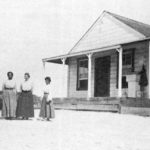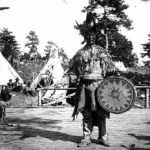Native peoples who had access to trees with sweet sap (such as the sugar maple) made sugar products just as later Europeans did in New England states like Vermont. In the spring, Chippewa families or groups of two to three families enjoyed working together at sugar camps. The families worked their own sugar bushes, which were stands of maple trees measured by the number of “taps” available. Each tree, for instance, might have two or three taps, and a bush might have 900 taps.
Each sugar camp usually contained a permanent lodge, which would be cleared of snow and repaired each spring, sometime around March. Women went early to examine their sugar-making utensils, like bark dishes for gathering sap, makuks (birchbark containers) for storing sugar, syrup buckets, and troughs where the buckets of sap were poured. When the equipment was ready, women went back to their home camps to fetch large kettles for boiling the sap; they also got the rest of their family ready to move to the camp. Both men and women were involved in setting up these sugar camps.
My next post will explain the Chippewa’s sugar-making process.

Ojibwe Woman Tapping a Sugar Maple, 1908, courtesy Elder Nmenhs-Arthur McGregor of Whitefish River First Nation







